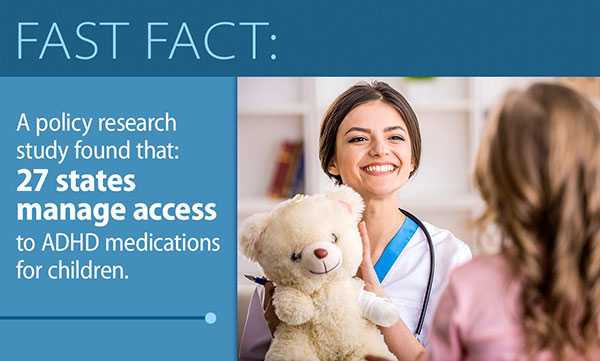Research
Overview
Attention-deficit/hyperactivity disorder (ADHD) is a serious public health problem affecting a large number of children and adults. CDC conducts research to expand on what is known about ADHD. The information learned will improve knowledge about the factors that increase the risk for ADHD, as well as the causes, and best treatments, and will aid the development of resources to help people living with ADHD. Learn more about CDC’s research on ADHD on this overview page.
ADHD can cause problems in how well children do in school, in their ability to make and keep friends, and in how they function in society. Although there are treatments to improve ADHD symptoms, more information is needed about managing ADHD so that children can learn and grow into adulthood without being impaired by their symptoms.

The criteria used to diagnose ADHD have changed over time. Researchers who study ADHD have used different definitions to diagnose ADHD. This has led to some disagreement about the number, characteristics, and outcomes of children with the disorder. Although the exact causes of ADHD are not known, research shows that genes play a role, but other factors may contribute or make symptoms worse. There are many unanswered questions about ADHD, and there is more we need to learn about how ADHD affects people throughout their life.
The treatment costs of ADHD and the personal and societal costs can be significant. Researchers estimate that in the United States, $31.6 billion is the combined annual cost for
- Health care for persons with ADHD specifically related to the diagnosis;
- Health care for family members of persons with ADHD specifically related to their family member’s diagnosis; and
- Work absences among adults with ADHD and adult family members of persons with ADHD.1
Improving the health of individuals with ADHD could result in substantial financial savings to families and society, potentially reducing this financial burden.
Current Research

Policy Research
In order to fully appreciate how children with ADHD are treated, one must understand the policies that affect how treatments are authorized and reimbursed by health plans. One policy that may affect medication treatment is for health plans or state programs to require pre-authorization before specific medications can be prescribed. Prescription prior-authorization policy means that the health plan or state program is required to review a physician’s prescription request before coverage for the medication is granted.
Over the past decade, the number of children being prescribed ADHD medications has increased substantially. In response to this trend, many state Medicaid programs have implemented prior-authorization policies for pediatric use of ADHD medications. These policies vary from state to state, and no comprehensive information on these policies was previously available.
To learn more about prior-authorization policies related to pediatric use of ADHD medications, CDC collaborated with Temple University to conduct a cross-sectional mapping study. Information was gathered on state Medicaid prior-authorization policies (as of November 2015) for prescribing ADHD medication to children. The study team collected
New Research: Medicaid policies to manage the use of ADHD medications: Information by state
- Prior-authorization forms,
- Memoranda from state Medicaid directors to prescribers,
- Drug utilization review board meeting notes, and
- State prescription drug lists.
The study team developed a coding scheme to capture and catalogue the key features of the prior-authorization policies. You can access a fact sheet with a summary of the results of this mapping study here and also access a database of state policies here.
A list of readings and resources on ADHD treatment policy options, including information on Medicaid drug prior authorization and reimbursement for behavioral therapy, is available here.
Healthcare Claims Data
CDC uses healthcare insurance claims data to understand treatment patterns for children in clinical care for ADHD, such as claims for psychological services and ADHD medication in patients covered by employer-sponsored insurance or by Medicaid.
Read more about the data from healthcare claims datasets.
National Surveys
CDC uses data from national surveys to understand the number of children with ADHD, other concerns and conditions they might experience, and the kind of treatment they might receive. Surveys that have data on children and on ADHD include

- National Survey of Children’s Health,
- National Health Interview Survey,
- National Survey on Children with Special Health Care Needs,
- and a new survey, the National Survey of the Diagnosis and Treatment of ADHD and Tourette Syndrome (NS-DATA)
Read about key findings from the national surveys.
Learn more about the data from the national surveys.
Community-based Research
CDC’s National Center on Birth Defects and Developmental Disabilities (NCBDDD) is funding large community-based, epidemiologic studies of ADHD in the United States. These studies
- Enhance what is known about ADHD and the co-occurring conditions in children and
- Increase the opportunity to make the most informed decisions and recommendations about potential public health prevention and intervention strategies for children with ADHD.
Project to Learn About Youth – Mental Health

The Project to Learn About Youth – Mental Health (PLAY-MH) is taking place in four communities. This project uses the same methodology as the original Project to Learn About ADHD in Youth (PLAY) project, but expands the focus to study a range of mental, behavioral, or emotional disorders including ADHD and tic disorders (such as Tourette syndrome). The project will provide valuable information that can be used for public health prevention and intervention strategies to support children’s health and development.
Study questions include
- What percentage of children in the community has one or more mental, behavioral, or emotional disorders?
- How frequently do these disorders appear together?
- What types of treatment are children receiving?
Project to Learn About ADHD in Youth (PLAY)
The Project to Learn About ADHD in Youth (PLAY) was a population-based research project with the University of South Carolina and the University of Oklahoma Health Sciences Center. It was conducted to shed more light on how many school-age children have ADHD, how the condition develops over time, what other conditions and risks children may experience, and about treatments they may receive. Data were collected to learn more about ADHD in diverse population groups, the quality and patterns of treatment, and the factors that affect short- and long-term outcomes for children.
Learn more about the original PLAY study.
Understanding Risk

It is not known what causes ADHD. ADHD is often seen in families, and genes appear to play a role, but other factors may contribute or make symptoms worse. For example, some environmental exposures have been linked to increased ADHD symptoms, but the evidence has been inconsistent. Knowing more about those factors would help with planning how to decrease the risk for ADHD. NCBDDD funded a comprehensive literature review of studies that investigate a large range of factors that might increase the risk for ADHD. The results will increase the ability of public health professionals to make the most informed decisions and recommendations about potential public health prevention strategies.
Research Agenda
Public health issues in ADHD can be divided into three areas:
- Understanding how many children have ADHD and whether they are properly diagnosed.
- Understanding and addressing the impact of ADHD in the population.
- Understanding which treatments are effective and which are best for children of different ages and in different communities.
Key public health questions yet to be answered include
- What are the causes, and the factors that increase the risk or severity of ADHD?
- How many children have ADHD? Is the rate increasing?
- How many children have ADHD and other conditions at the same time?
- What social and economic impacts does ADHD have on families, schools, the workforce, and the judicial and health systems?
- Are ADHD and other co-occurring conditions conditions being appropriately diagnosed and treated?
- Are people with ADHD able to access appropriate and timely treatment?
- How effective are the treatments and what are their long-term effects?
Highlighted Articles
Key Findings: National profile of ADHD diagnosis and treatment in young children
Learn about the rates of diagnosis, medication, and behavior treatment in children aged 2 to 5 years in 2011-2012
(Published: July 18, 2017)
Key Findings: Treatment of Disruptive Behavior Problems – What Works?
Learn about current evidence on the most effective treatments for behavior problems in children
(Published: May 1, 2017)
Impact of ADHD and Other Mental Conditions
Data from a community study show that children with ADHD and other conditions are more likely to have problems with friendships and to get into trouble in school or with the police.
(Published November 25, 2015)
How US Children are Diagnosed with Attention-Deficit/Hyperactivity Disorder
The first national study presenting greater detail on how ADHD diagnoses take place among a representative sample of children who have ADHD, as described by their parents.
(Published September 3, 2015)
Medication and Behavioral Therapy for ADHD
Patterns of ADHD treatment among children with special health care needs, 2009-10.
(Published April 1, 2015)
Estimates of ADHD Change Depending on Which ADHD Criteria Are Applied
Using more criteria for ADHD decreases the percentage of children who fit the diagnosis.
(Published November 11, 2014)
Persistence of Attention-Deficit/Hyperactivity Disorder Symptoms
Data from a community sample show that certain ADHD symptoms can often last into adolescence.
(Published July 3, 2014)
Trends in ADHD Diagnosis and Medication Treatment 2003-2011
Data on trends and age of diagnosis across 3 survey time points.
(Published November 22, 2013)
ADHD Diagnosis
Parent report is a valid measure of attention-deficit/hyperactivity disorder diagnosis.
(Published: May 14, 2013)
Learn More About ADHD – It’s the First Step
Learning more about ADHD is the first step to an accurate diagnosis and effective treatment for individuals and families, as well as for the professionals who treat and support them.
(Published: October 11, 2016)
Vital Signs: ADHD in Young Children
Use recommended treatment first.
(Published: May 3, 2016)
Behavior Therapy First for Young Children with ADHD
Learn about using parent behavior therapy first to help young children with ADHD.
(Published: October 12, 2015)
Is it ADHD?
Learn about the symptoms of ADHD and what to do if you’re concerned that your child might have this disorder.
(Published: April 21, 2015)
Smoking in Pregnancy: A Possible Risk for ADHD
CDC looked at any association between smoking during pregnancy and ADHD.
(Published: October 10, 2014)
ADHD: Keeping Track of the Numbers
Discover how CDC’s latest research helps us all understand how ADHD impacts children and families.
(Published: November 22, 2013)
Previous Workshop Summaries
- Epidemiologic Issues in ADHD Workshop (April 14, 1999)
- Public Health Issues in ADHD: Individual, System, and Cost Burden of the Disorder (May, 17, 1999)
- ADHD Long-term Outcomes: Comorbidity, Secondary Conditions, and Health Risk Behaviors (June 9, 1999)
- Public Health Issues in the Treatment of ADHD Workshop (June 15, 1999)
References
Birnbaum HG, Kessler RC, Lowe SW, Secnik K, Greenberg PE, Leong SA, et al. Costs of attention deficit-hyperactivity disorder (ADHD) in the US: excess costs of persons with ADHD and their family members in 2000. Current medical research and opinion 2005;21(2):195-206.
- Page last reviewed: September 6, 2017
- Page last updated: September 6, 2017
- Content source:


 ShareCompartir
ShareCompartir